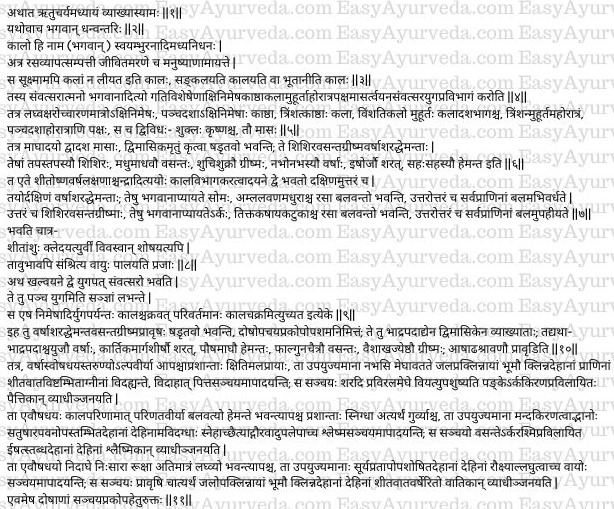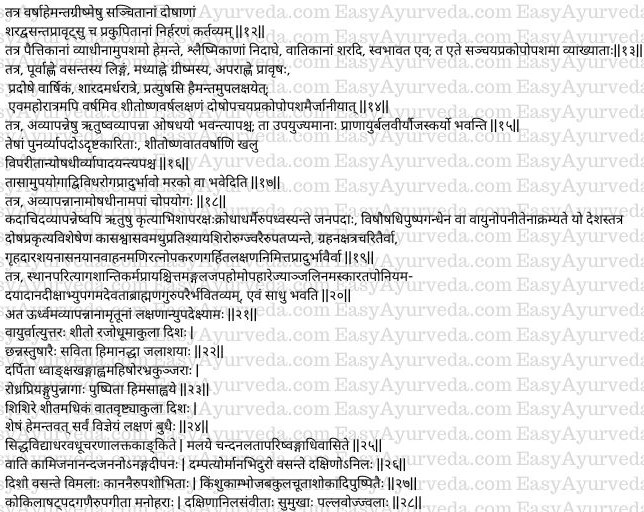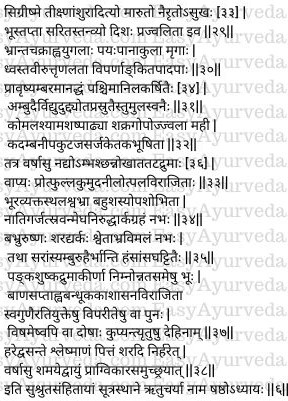
This article explains Sushruta Samhita Sutrasthana Chapter 6 “Ritucharya Adhyaya” – Seasonal regimen.
Ritucharya Adhyaya
We will now expound the chapter “Ritucharya – seasonal regimen”, as revealed by the venerable Dhanvantari.
Read – Ritucharya – Healthy Seasonal Regimen – Introduction, Divisions
Kala – Time
Kala, is the name of the Divinity, which is self-born (not manifested from anything else), has no beginning, middle or end. Abnormalities and excellences of sweet, sour, etc. tastes (of all substances) and life and death of human beings are dependent on the kala. It is called “Kala” since it does not spare even minute things (without causing change), since it makes all things into one group, and since it brings about death (destruction) of all living beings.
Note: That which we call “kala or time” is actually “Parinama” i.e., changes taking place constantly. Considering these, we fix a certain period and express it in units of measurement. Everything in this creation, living and non-living, big or small is undergoing constant change and nothing can escape change. So, time is considered eternal and inexorable. Master Dalhana in his commentary interprets the term “Na Liyate” as not adhering to / not attaching even to minute objects, because of its constant movement. He gives two or three meanings for the term “Sankalayati” such as –
- makes all living things to form one group because of its nature of destroying all
- it influences living beings with happiness and misery
- it shortens life and
- it takes living being near to death
Read – Kala – The Time Factor
Kala Vibhaga
Division of time
God Aditya (Sun) by his special movement brings about divisions in the ever moving (ever changing) time (which is in the form of samvatsara – year). The divisions are as below mentioned –
- Nimesha (Aksinimesha)
- Kastha
- Kala,
- Muhurta,
- Ahoratra,
- Paksha,
- Masha,
- Samvatsara and
- Yuga
Detailing of divisions of time
- Akshinimesha (winking the eyelids) – It is the time required for pronouncing a soft alphabet.
- Kastha – fifteen aksinimesas make one kastha.
- Kala – Thirty kasthas make up one kala.
- Muhurta – Twenty kalas make one muhurta or one tenth of kala.
- Ahoratra (one day and night / day-night) – Thirty muhurtas form one ahoratra.
- Paksha (fortnight) – Fifteen ahoratra makes one paksa. This is of two kinds i.e., sukla (bright / white fortnight) and krsna paksa (black / dark fortnight).
- Masa (month) – Two fortnights make one masa i.e., 1 month.
Notes:- Calculated in terms of the present-day units of time, the above works out as follows:-
1 Ahoratra = 30 Muhurta = 24 hours = 1440 min = 86400 secs.
1 Muhurta = 20 Kala = 0.8 hours = 48 min = 2880 secs.
1 Kala = 20 Kastha = 0.04 hours = 2.4 min-144 secs
1 Kaastha = 15 Nimesa = 0.8 min = 4.8 secs
1 Nimesa = 192 microsecond = 0.3 secs
Read – Kala Samprapti – Understanding Pathogenesis On Basis Of Effect Of Time On Doshas
Shadritus – Six seasons
In one samvatsara i.e., in one year there are Magha etc. twelve masas (months).
Two such masas (months) make one Ritu (season). In this way one year or 12 months constitute six Ritus – seasons. They are –
- Shishira – cold / dewy season – late winter
- Vasanta – spring season
- Grishma – summer season
- Varsha – rainy season
- Sharat – autumn season and
- Hemanta – early winter season
Name of the months forming each season
- Tapa (Magha) and Tapasya (Phalguna) months form Shishira season.
- Madhu (Chaitra) and Madhava (Vaishaka) months form Vasanta season.
- Shuchi (Jyestha) and Shukra (Ashadha) months form Grishma season.
- Nabha (Sravana) and Nabhasya (Bhadrapadha) months form Varsa season.
- Isha (Ashvina / Ashwayuja) and Urja (Kartika) months form Sarad season.
- Saha (Margashira) and Sahasya (Pausha) form Hemanta season.
Read – Ritucharya – Ayurvedic Seasonal Regimen – 3rd Chapter – Ashtang Hriday
Note:- This ancient calendar can be equated with modern calendar as follows:-
| Months | Seasons | |
| 1 | Magha- Phalguna (mid- Jan to Mid-March) | Shishira ritu (cold/ Dewy season) |
| 2 | Caitra-Vaishakha (mid-March to Mid-May) | Vasanta ritu (Spring season) |
| 3 | Jestha- Ashadha (mid- May to mid-July) | Grishma ritu (summer season) |
| 4 | Shravana- Bhadrapada (mid-July to mid-sep) | Varsha ritu (autumn season) |
| 5 | Ahsvayuja-Kartika (mid-Sep to mid Nov) | Sharat ritu(Autumn season) |
| 6 | Margashira-Pausha (mid- Nov to Mid Jan) | Hemanta ritu (winter season) |
Read – Dakshinayana or Visarga Kala (Southern Solstice) Definition, Seasons, Health Effect
Ayana Dvaya – Two Solstice
These six ritus (seasons) characterized by predominance of cold, heat and rain are divided into two Ayanas (solstice, semesters) i.e., Dakshina Ayana (southern solstice) and Uttara Ayana (northern solstice) on the basis of predominance of effects of the sun and moon.
Among these seasons, Varsha, Sharat and Hemanta form the Dakshina Ayana (Southern Solstice). During these seasons, Lord Soma (moon) is predominant. Likewise, sour, salt and sweet tastes are more powerful (in these seasons). The strength of all the living beings goes on increasing successively day after day.
Shishira, Vasanta and Grishma seasons together form Uttarayana (Northern Solstice). During these seasons Lord Arka (Sun) is predominant. In these seasons – bitter, astringent and pungent tastes are powerful. Herein the strength of all the living beings goes on decreasing successively day after day.
One verse here:-
Shitamshu (Moon) moistens the earth (by the influence of its cold rays). On the other hand, Vivasvan (Sun) dries it (the earth) up. Getting associated with both of them (moon and sun), the Vayu (Wind) would protect (support) all the living beings).
Kala Chakra
Time Wheel
Samvatsara – The two Ayanas (Solstice / semesters) i.e., southern and northern solstice together form one Samvatsara (year).
Yuga – Five such samvatsaras (years) together are called Yuga.
Kalachakra – This kala (time) commencing with nimesha and ending with yuga rotates like a wheel (continuously) and hence called Kalachakra (the wheel of time), so says some authorities (Experts).
In this science (Ayurveda) – Varsha, Sharat, Hemanta, Vasanta, Grishma, and Pravrut – are the six ritus (seasons) which are the causes for Upachaya (mild increase), Prakopa (aggravation) and Upashama (decrease to normal) of the Doshas (Vata, Pitta, and Kapha). Each of these seasons are formed by 2 months (of a year) together i.e., 2 months constitute one season commencing from Bhadrapada (each season comes once in two months in a cyclic way): such as Bhadrapada and Ashwayuja together form Varsha ritu (rainy season), Kartika and Margasirsa together form Sarat (Autumn) Pausha and Magha for Hemanta (winter), Phalguna and Chaitra form Vasanta (spring): Vaishakha and Jyeshta form Grishma (summer); Ashadha and Shravana form Pravrut (early rainy season).
Read – 15 Ayurvedic Health Tips For Spring Season
Ritu Prabhava
Effects of the seasons
In Varsha ritu (rainy season), the plants (especially food crops such as cereals, pulses etc.) are young / tender and possess little potency (properties). The water becomes contaminated with the waste materials of the earth and hence is not clean and clear.
The sky is full of clouds. The earth is greatly inundated with water. In such conditions, the bodies of the living beings will have more moisture and the agni (digestive fire) would become extremely weak due to the influence of cold wind. If these persons consume such plants (as food) and water, they would develop a burning sensation (excessive heat) inside the body.
This burning sensation (excessive heat) would give rise to Sanchaya (mild increase) of pitta. This accumulated pitta undergoes prakopa (severe increase) in Sharad Ritu (autumn – the next season), in which the sky comprises scattered clouds, the sun’s rays dry up the slush (moisture of the earth) and produces diseases of pitta origin.
During the Hemanta (winter) season, the same plants undergo change in their potency (potency gets matured), because of change of time (seasons) and become powerful. The water becomes clear, unctuous and very heavy (heavy to digest). In this season due to the mildness (mild nature) of the sun rays (not hot and intense) and due to contact and exposure to breeze consisting of snow, the body of persons would be stiffened (slight inactivity). The medicines and water administered to these persons would get converted into madhura vipaka (sweetness after digestion) and by their unctuousness, coldness, heaviness and stickiness, cause Sanchaya (mild increase) of Kapha. This kapha which has undergone mild increase will melt down due to the effect of heat of the sun rays coming into contact with the body in the next season i.e., vasanta ritu – spring season, undergo prakopa (great increase, aggravation) and causes diseases of kapha origin in the bodies of men (and other animals) whose bodies have stiffened (have become inactive slightly due to the impact of the seasons) due to the seasonal impact.
The same plants become devoid of their essence, become dry and light (light for digestion) during the next season Nidagha (Grishma – summer). The water also acquires the same qualities during this season. When persons (and animals) whose body has become dry due to the effect of extreme heat of the sun consume these plants (as food), medicines and water, they bring about sanchaya (mild increase) of vata due to their dryness, lightness and non-unctuousness. This vata which has mildly increased would undergo prakopa (great increase, aggravation) during the next season i.e., pravrut ritu (early rainy season) when both the earth and bodies of men and animals get extremely moist and produce diseases of vata origin, stimulated by coldness, wind (cold breeze) and rains.
Thus, was described the causes for Sanchaya (mild increase) and Prakopa (great increase) of the Doshas.
Read – Relationship Of Doshas With Seasons
Notes:- Sanchaya (mild increase) and Prakopa (great increase) of Doshas in respect of Seasons can be Tabulated as follows:-
| Varsha Sharad Hemanta Vasnta Grishma Pravrut | |
| Vata
Pitta Kapha |
Sanchaya Prakopa
Sanchaya Prakopa |
| Think of removing this tab Proper time for elimination of doshas | |
Doshas which have undergone mild increase in Varsha, Hemanta and Grishma, and severely aggravated during Sharat, Vasanta and Pravrut, should be eliminated as indicated in the classics.
Diseases produced by Pitta subside during Hemanta. Diseases produced by Kapha subside during Nidagha (Grishma). Diseases produced by Vata subside during Sharad – this is natural only.
Thus, were described the mild increase, great increase and mitigation of the Doshas.
Dina-Ritu-Bhava
Day and seasons
During forenoon the features / qualities of Vasanta ritu (spring season) should be expected in the body.
During midday the qualities of Grishma (summer) are found.
During the afternoon the qualities of Pravrut (early rainy season) are found.
During evening time, the qualities / features of varsua (rainy season) are found.
During midnight the qualities / features of suarat (autumn season) are found.
During early morning, the qualities of Hemanta (winter season) are found.
In this manner, the qualities of seasons such as cold, heat and rain should be understood as happening every day and night, just like they happen in a year, these shall be understood by mild increase, great increase (aggravation) and mitigation of doshas.
Read – Doshas in Relation to Age, Season and Time of Day
Avyapanna- ritu
Unvitiated / Normal seasons
When the ritus (seasons) are not abnormal (i.e., the seasons are normal – exhibiting their usual features) they are called as avyapanna ritus i.e., uncontaminated / normal seasons. In these seasons, both plants and water will also be normal (having their normal qualities). By their use, life activity, span of life, strength, vigour and vitality of men and animals become augmented.
Ritu Vyapat
Abnormality of seasons
The abnormalities of seasons are caused by adrista (non-righteousness, adharma). The abnormalities occurring in cold, heat, wind and rain will also cause abnormalities in plants, medicines and water. (Herein cold, heat, wind and rain will become different and have abnormal qualities other than their normal qualities. The same is true with plants and water.)
By use of these plants and water, many kinds of diseases or pandemics / epidemics are caused.
When the seasons are contaminated and cause different diseases and epidemics, the plants (medicines) and water which are not contaminated shall be used (for treatment, as remedies).
Read – Ayurvedic Seasonal Regimen Based on Different Climatic Conditions
Ritu Vyaapat
Diseases caused due to vitiated / abnormal seasons
Sometimes in spite of the seasons not being contaminated / vitiated i.e., seasons being normal, communities (of man and other living beings) suffer and get destroyed by the effects of sorcery, curses, anger of evil spirits (demons) and unrighteous behaviour of the people.
Sometimes, the country would get vitiated by the smell of poisonous plants and flowers carried by the wind. The people living in such countries become affected by diseases like cough, dyspnoea, vomiting, nasal catarrh, headache, fever etc. which are not different from the dosha prakriti (constitution of the body).
Other times one would suffer from diseases caused due to the bad effects (inauspicious effects) of planets and stars. Also, sometimes diseases are manifested due to the effects of malevolent qualities of the house, wife, cot, seat (furniture), vehicles, riding animals, precious stones, gems and household equipment etc. Diseases may also be caused due to many other signs which would suggest inauspiciousness (ominous signs).
Read – Ayurvedic Winter Regimen – 75 Diet And Lifestyle Tips
Vyapanna Ritu charya
Regimen during abnormal seasons
At such times, people should resort to one or all of the below mentioned remedies –
- Sthana parityaga – change of place of living (migrate to other places),
- Shanti karma – pacificator rites
- Prayaschitta – expiatory activities
- Mangala – auspicious rituals
- Japa – chanting of hymns
- Homa – fire sacrifices
- Upahara – oblations to Gods
- Yajna – special fire sacrifices
- Baddanjali Namaskara – prostration to deities with folded hands
- Tapa – doing penances
- Niyama – observing vows and restraints
- Daya – showing compassion
- Dana – giving charity
- Deeksha – getting initiated by preceptors and
- Abhyupagama Devata Brahmana Gurubhavaih bhavitavyam – remaining in the company of Gods, Brahmanas and preceptors (and carrying out their mandates)
By these, there will be benefits.
Sanskrit Versus



Avyapanna Ritu Lakshana
Features during normal seasons
Further on, we will describe the characteristic normal features of the seasons:
Hemanta ritu: During Hemanta ritu, cold wind blows from the north. All the directions (quarters, space around) are covered with dust and smoke. The sunrays are enveloped (hindered) by fog. The reservoirs of water are covered with snow (mist). Crows, rhinoceros, buffalos, camels and elephants are intoxicated (joyous). There is blooming (flowering) of Rodhra, Priyangu and Punnaga trees.
Shisira Ritu : Cold is more during Shishira ritu (late winter). All the directions (quarters, spaces around) are vitiated (surrounded) by breeze and rain. The other features of Shishira season are the same as in Hemanta Ritu (early winter season).
Vasantha Ritu:- During Vasanta (spring), on the Malaya mountains having the foot prints of lac painted on the feet of maidens (nymphs, brides) of Siddhas and Vidyadharas, the southern winds (of Malayagiri) carrying the sweet fragrance of the jasmine etc. flowers climbing on the sandalwood trees (the winds coming in contact with the flowers and sandalwood trees) flow, producing pleasure in amorous persons, provoking the God of sex (enhances sexual desire in amorous persons), and smites the pride of the couple.
Apart from this, in spring season all the directions (space, quarters) are clear, being decorated by forests and gardens filled with flowering plants and trees including Kimshuka, Ambhoja, Bakula, Cuta, Ashoka etc. and melodious tunes of herds of cuckoo and bees. Hanging creepers filled with beautiful red coloured tender leaves shaken by the southern wind would captivate one’s mind in this season.
Grishma ritu:- During Grisma (summer) the sun rays are hot and intense. The wind blows from the Nairutya direction (southwest) and is unpleasant and troublesome. The earth gets heated up due to the heat of the sun. The rivers will have less water. All directions (quarters) would appear as if burning. Pairs (herd) of Chakravaka birds keep wandering here and there aimlessly (in search of water). The deer and other animals run about here and there anxious to find water for drinking. Small trees, grass and creepers get destroyed (dried up) and the trees get devoid of leaves (since the leaves dry and fall off).
Read – Ayurvedic Health Tips For Summer Season
Pravrut ritu:- In varsha ritu (early rainy season) the sky is full of clouds. These clouds are driven by the western breeze and produce lightning and roaring thunder. The earth is covered with plenty of slender, young grass and brightened by plenty of Sakragopa (Indragopa – cochineal insects). Kadamba, Nipa, Kutaja, Sarja and Ketaki trees become decorated with flowers.
Varsha ritu:- In Varsha ritu (Rainy season), the rivers are full of water. Due to their powerful waves and flooding the river water tends to uproot the trees along the banks. The ponds are filled with blooming flowers like kumuda and nilotpala. Since the earth is covered with grass all over, the pits and depressions on the ground are not seen clearly. The earth appears pleasant with plenty of vegetation. The clouds do not produce roaring sounds. The sun and stars are hidden behind the thick clouds in the sky.
Sharat ritu:- During Sharat ritu (autumn) the Sunrays are brownish in colour and hot. The sky would appear clear due to the presence of white clouds. The ponds and lakes are full of lotus flowers being scattered by the swimming swans. The earth (ground) would have slush, dryness (dried regions) and ants (which make the anthill) all around, in its lower (depressed areas), upper (elevated areas) and even surfaces. Bana, Saptahva, Bandhuka, Kasa and Asana trees adorn the land.
Read – Ayurvedic Health Tips For Autumn Season
Seasonal variations and doshas
Doshas (Vata, Pitta and Kapha) present in the body of man, undergo prakopa (great increase / aggravation due to improper-manifestation of normal qualities of the seasons either in excess, inadequate or opposite manner.
Seasonal elimination of the doshas
The aggravated Shleshma (Kapha) should be eliminated during Vasanta: pitta during Sharat and vata during Varsha seasons, before they produce diseases.
Thus ends the sixth chapter by Name Ritucharya in Sutra Sthana of Sushruta Smahita.










